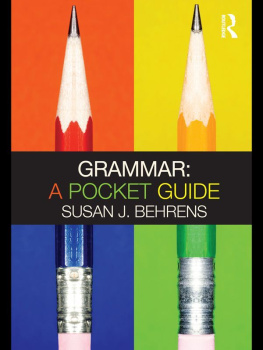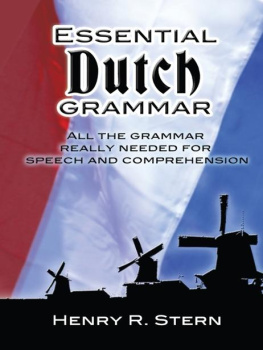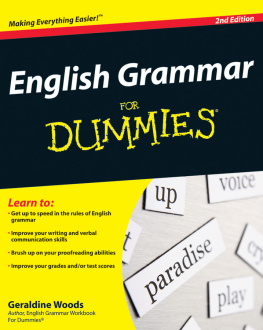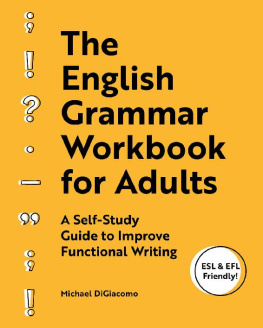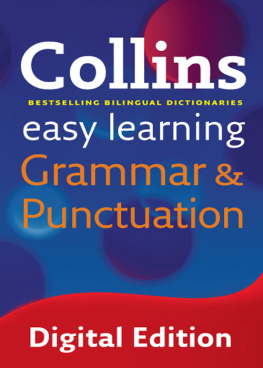Grammar: A Pocket Guide
If youve ever wanted a quick and easy guide to verbs and adverbs, commas and apostrophes, clauses and prepositions, then this is a must-have book for you. Easing readers gently into the study of the structure of English, Grammar: A Pocket Guide covers common questions such as:
Is it 10 items or less or 10 items or fewer?
Should I say If I were you or if I was you?
Can you start a sentence with And or Because?
When do you use whom?
What is the difference between lie and lay?
Is it I feel bad or I feel badly?
Using examples from everyday speech and writing, this handy book cracks the code of off-putting grammatical jargon so that readers can enjoy learning how to think and talk about grammar. With practice exercises, a glossary, and suggestions for further reading, Grammar: A Pocket Guide is the perfect foundation for anyone wanting to improve his or her writing and communication.
Susan J. Behrens is Professor of Communication Sciences and Disorders at Marymount Manhattan College, and an associate of the Institute for Writing and Thinking at Bard College. She is co-editor of Language in the Real World with Judith A. Parker (Routledge, 2010).
SUSAN J. BEHRENS
Grammar: A Pocket Guide

LONDON AND NEW YORK
First published 2010
by Routledge
2 Park Square, Milton Park, Abingdon, Oxon, OX14 4RN
Simultaneously published in the USA and Canada
by Routledge
270 Madison Avenue, New York, NY 10016
Routledge is an imprint of the Taylor & Francis Group, an informa business
This edition published in the Taylor & Francis e-Library, 2010.
To purchase your own copy of this or any of Taylor & Francis or Routledges collection of thousands of eBooks please go to www.eBookstore.tandf.co.uk.
2010 Susan J. Behrens
The right of Susan J. Behrens to be identified as author of this work has been
asserted by her in accordance with sections 77 and 78 of the Copyright,
Designs and Patents Act 1988.
All rights reserved. No part of this book may be reprinted or reproduced or
utilized in any form or by any electronic, mechanical, or other means, now
known or hereafter invented, including photocopying and recording, or in
any information storage or retrieval system, without permission in writing
from the publishers.
British Library Cataloguing in Publication Data
A catalogue record for this book is available from the British Library
Library of Congress Cataloging in Publication Data
Behrens, Susan J., 1959
Grammar : a pocket guide / Susan J. Behrens.
p. cm.
1. English languageGrammarProblems, exercises, etc. I. Title.
PE1112.B44 2010
428.2dc22
2010012366
ISBN 0-203-84286-3 Master e-book ISBN
ISBN 10: 0415493595 (pbk)
ISBN 10: 0203842863 (ebk)
ISBN 13: 9780415493598 (pbk)
ISBN 13: 9780203842867 (ebk)
For Frank Behrens, my father
Contents
A note of thanks
Many people deserve thanks for their valuable assistance. The great team at Routledge helped make this book possible: David Avital and Amanda Lucas in the early days, and Sophie Thomson, Katherine Ong, and the good folks at Keystroke in the crunch year. To the anonymous reviewers: your thoughtful comments and suggestions helped make this book even better with each revision.
Next, thanks to Lewis Frumkes for giving me the idea for this book over one of our lunches. At Marymount Manhattan College, Jerry Williams was a big supporter right from the start. Appreciation to Dean David Podell (with hello to the other Franklin) for looking favorably on my leave in spring 2010. Cindy Mercer kept me laughing and cultured. Big thanks to my friend, chair, and mentor at Marymount, Ann Jablon, for endless support and encouragement. Also thanks to alumni Cameron P. Kelsall and Karina Towers. My colleagues at the Institute for Writing and Thinking have kept me, well, writing and thinking since 1997. New York Universitys Faculty Resource Network provided the lectures of Richie Kanye. Then there are my loyal friends: Carole Tain Soskin, Nancy Nicolelis, Ann Marie Tevlin Peterson, Michael Kandel, Don Kortlander, and Judith A. Parker (especially for sharing book time).
There is, of course, my husband, who listened to every story nightly over dinner, read every page of this manuscript, and is so wise. My family Kate, Richard, Shirley, Ed, Jenna, and the Oregon gang: thanks for being there. Finally, there is my father, Frank, my first grammarian and role model for what an excellent teacher is and can continue to be over many years. This book is dedicated to him.
As for all my students who have helped me grow with their challenging questions, eagerness to learn, and respect, I repay them in a small way by using their first names throughout the books examples and exercises.
Introduction
Grammar: A Pocket Guide covers the key areas of English grammar. It is intended to ease the adult learner into the study of the structure of English with a comfortable approach that both reassures the reader and insures a successful and rewarding experience. The perspective I take on grammar comes from my discipline, linguistics, which holds that all of us have an internalized grammatical competence: an instinctive feeling about sentence structure and what sounds right to us. An implicit knowledge, however, does not necessarily easily translate into explicit understanding; nor does it always give us access to the type of grammar necessary for educational and professional success.
In other words, while you might claim that your grammar is terrible, such a feeling probably reflects the difference between your own grammatical forms and what is demanded in college and the workplace in both writing and speaking. In fact, you almost certainly already have a full grammatical system, one that is not that far off from the grammar mastery teachers demand. While the linguistic distance between someones intuitions about grammar and the standard forms might be small, the educational and social consequences can be great. That is where this book comes in.
Non-standard forms dont arise from our linguistic competence deserting us; we all have grammatical rules we follow. However, when those rules dont produce standard forms, we run the risk of professional and educational disapproval.
This discussion of differences, though, requires an explanation about the labels I use. Most people equate Standard English with grammatical and correct, and forms that deviate from the standard with errors; in fact, most teachers will readily mark as a mistake anything (grammar, usage, spelling) that deviates from the standard rules. Linguists explore language varieties dialects of a language and try to understand their internal structure. Thus, we rarely label a form wrong or ungrammatical if it is used by a speaker with full linguistic competence.
The label ungrammatical, instead, is reserved for structures that speakers of the language would reject as ill-formed, such as Cat the laptop on the sits, or less grossly, The cat finds in the grass. For constructions like these examples, I place an asterisk before the structure, denoting a non-occurring form: *Cat the laptop on the sits and *The cat finds in the grass. For sentences that do not follow Standard English grammar but are considered well formed by the rules of non-standard dialects, e.g. Heres some books to read, or This is mines, I flag them as examples of non-standard grammar but do not use an asterisk.

